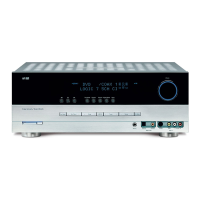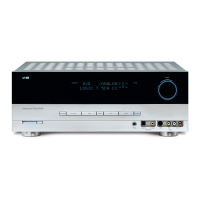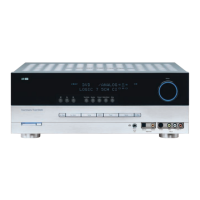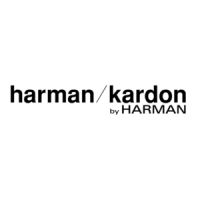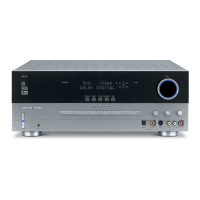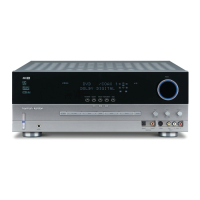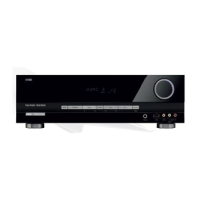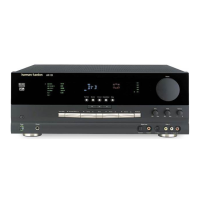others, without reducing the impact of the digital
source. The Night mode is available only when Dolby
Digital signals with special data are being played.
The Night mode may be engaged when a Dolby
Digital DVD is playing by pressing the
Night Mode
Button
l on the remote. Next, press the
⁄
/
¤
B
uttons
n t
o select either the middle range or
full compression versions of the Night mode. To turn
the Night mode off, press the
⁄
/
¤
Buttons n
until the message in the lower third of the video dis-
play and in the
Lower Display Line Q reads
D
-RANGE OFF
.
The Night mode may also be selected to always be on
at either level of compression using the options in the
DOLBY menu. See page 19 for information on
using the menus to set this option.
IMPORTANT NOTES ON DIGITAL PLAYBACK:
• When the digital playback source is stopped, or
in a pause, fast-forward or chapter-search mode,
the digital audio data will momentarily stop and
the
channel position letters inside the Speaker/
Channel
Input Indicators O will flash. This is
normal and does not indicate a problem with either
the AVR 140 or the source machine. The AVR 140
will return to digital playback as soon as the data is
available and when the machine is in a standard
play mode.
• When playing DVDs or viewing TV signals with digi-
tal audio, the number of channels and format of the
incoming bitstream may vary depending on the por-
tion of the DVD being viewed (e.g., trailers, director’s
commentary), or when commercials or local station
identification is broadcast.
The AVR 140 will auto-
matically react to changes in the incoming signal.
• Some television system broadcasters are not capa-
ble of transmitting a 5.1 digital signal.
Therefore,
although the program material may be encoded in
the Dolby
Digital or DTS formats, the actual broad-
cast may only be a 2.0 signal. Check with your
cable or satellite provider for more information.
• Although the AVR 140 will decode virtually all current
DVD movies, CDs and HDTV sources, it is possible
that some future digital sources may not be compati-
ble with the AVR 140.
• Not all digitally encoded programs contain full 5.1-
or 6.1-channel audio. Consult the program guide
that accompanies the DVD
to determine which
type of audio has been recorded on the disc
.
The AVR 140 will automatically sense the type
of digital surround encoding used and adjust to
accommodate it.
•
When some digital sources are playing
,
you may
not be able to select some of the analog surround
modes such as Dolby Pro Logic II or IIx, Dolby 3
Stereo, Hall, Theater or Logic 7. Refer to the tables
on page 32 for more information.
• When a Dolby Digital or DTS source is playing, it is
not possible to make an analog recording using the
Tape Outputs £ and Video 1 Audio Outputs
k. However, the digital signals will be passed
through to the
Digital Audio Outputs fl‡.
Tuner Operation
T
he AVR 140’s tuner is capable of tuning AM, FM and
FM Stereo broadcast stations. Stations may be tuned
manually, or they may be stored as favorite station
presets and recalled from a 30-position memory.
Station Selection
1. Press the AM/FM Tuner Select Button g on
the remote to select the tuner as an input. The
tuner may be selected from the front panel either
by pressing the
Input Source Selector ^ until
the tuner is active or by pressing the
Tuner Band
Selector
!.
2. Press the
AM/FM Tuner Select Button g or
Tuner Band Selector ! again to switch between
AM and FM so that the desired frequency band
is selected.
3. Press the
Tuner Mode Button
&
I to select
manual or automatic tuning.
When the button is pressed so that
AUTO
appears in the Lower Display Line ı each
press of the
Tuning Selectors 9u will put
the tuner in a scan mode that seeks the next higher
or lower frequency station with acceptable signal
strength. An
AUTO ST TUNED indication
will momentarily appear when the station stops
at a stereo FM station, and an
AUTO TUNED
indication will momentarily appear when an
AM or
monaural FM station is tuned.
Press the Tuning but-
tons again to scan to the next receivable station.
When the button is pressed so that
MANUAL
appears in the Lower Display Line ı each tap
of the Selector will increased or decrease the fre-
quency by one increment. When the tuner receives
a strong-enough signal for adequate reception,
MANUAL
TUNED
will appear in the Lo
wer
Display Line
ı.
4. Stations may also be tuned directly in either the
automatic or manual mode. To enter a station’s
frequency directly, first select the AM or FM band
as desired be pressing the
AM/FM
T
uner Select
Button
g. Next, press the Direct Button J.
Within five seconds of seeing the
DIRECT IN
scroll in the Upper Display Line P, enter the
station frequency by pressing the
Numeric Keys
r.
If you press an incorrect button while entering
a direct frequency
,
press the
Clear Button W to
start over.
NOTE: When FM reception of a station is weak, audio
quality will be increased by switching to Mono mode
by pressing the
Tuner Mode Button
&
I so
t
hat
M
ANUAL
a
ppears momentarily in the
L
ower
D
isplay Line
ı a
nd goes out. This will also activate
manual tuning mode.
P
reset Tuning
Using the remote, up to 30 stations may be stored in
the AVR 140’s memory for easy recall using the front-
panel controls or the remote.
T
o enter a station into the memory, first tune the
station using the steps outlined above. Then:
1. Press the
Memory Button X on the remote.
Two underscore lines will appear at the far right
side of the
Upper Display Line P.
2. Within five seconds, press the
Numeric Keys r
corresponding to the location where you wish to
store this station’s frequency. Once entered, the
preset number will appear in the
Upper Display
Line
P.
3. Repeat the process after tuning any additional
stations to be preset.
Recalling Preset Stations
• To manually select a station previously entered in
the preset memory, press the
Numeric Keys r
that correspond to the desired station’s memory
location.
• To manually tune through the list of stored preset
stations one by one, press the
Preset Stations
Selector Buttons
$T on the front panel
or remote
.
Recording
In nor
mal operation, the audio or video source
selected for listening through the AVR 140 is sent to
the record outputs
.
This means that any program you
are watching or listening to may be recorded simply
by placing machines connected to the
Tape Outputs
£ or Video 1 Audio/Video and S-Video Outputs
ek in the Record mode
.
When a digital audio recorder is connected to the
Digital Audio Outputs fl‡, you are able to record
the digital signal using a CD-R, MiniDisc or other digital
recording system.
NOTES:
• The digital outputs are active only when a digital sig-
nal is present, and they do not convert an analog
input to a digital signal, or change the format of the
digital signal. In addition, the digital recorder must
be compatible with the output signal.
F
or example,
OPERATION
OPERATION
33OPERATION
33
AVR 140 OM 3/29/06 3:45 PM Page 33
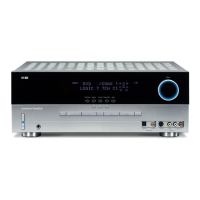
